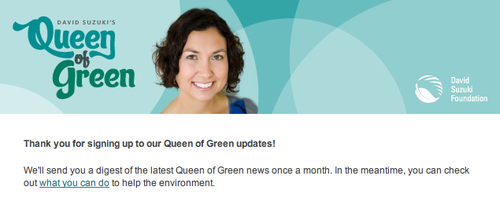
Queen of Green emails
While I’m mainly devoted to the web in my design practice as well as at my job, I do wear many hats in my work at the David Suzuki Foundation. I recently took on a rebrand of David Suzuki’s Queen of Green, the Foundation’s expert on green living and one of our most public faces. The Queen of Green, Lindsay Coulter, writes a weekly blog, offers tips and recipes, and has regular media appearances. Her recipes and other public materials lacked cohesive, formally executed branding, so when it was time to have a fresh go at the content of her resources, we gave her work a proper identity.
Continue reading David Suzuki’s Queen of Green gets a facelift — the brand, that is »
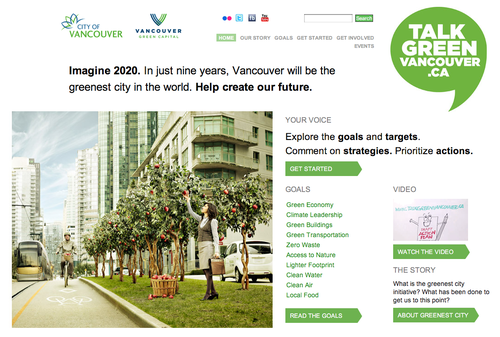
Come collaborate, brainstorm, and meet other green keeners (like me!) at the Greenest City Camp on Saturday, March 5th!
The “unconference” is “a full-day of learning, connecting and finding allies and collaborators to make Vancouver the Greenest City in the world by 2020. This is your chance to connect with Vancouver residents and organizations that are passionate about making this a green city and find out how we can move forward together. It’s about finding people, and the resources, to do what you always wanted to do”, like creating a laneway community garden with your neighbours or reducing waste at work.
If that didn’t already get you stoked, there will be food. Mmm, food! the connector of people.
And there’s more…
If you’re baffled by camp idea, sign up anyway and check out this camp prep webinar March 3.
The Greenest City Webinar on March 4 is kind of a “The Plan: 101” so if you’re not up to speed on this (which you should be, cos it’s awesome and exciting), this is your chance to sit back and get educated before the unconference.
And there are a couple zero waste events on March 2nd, with more info on the Talk Green Vancouver events page.
Now go register for the unconference!
 This daily green blog challenge is in celebration of David Suzuki’s 75th birthday, supporting the David Suzuki Foundation. Please help me out by sponsoring me online now.
This daily green blog challenge is in celebration of David Suzuki’s 75th birthday, supporting the David Suzuki Foundation. Please help me out by sponsoring me online now.
Note: I am writing solely on my own behalf, and do not claim to represent the David Suzuki Foundation or its views here.

El Naturalista (left), Simple sneaks
I’m going to start with the caveat: you cannot buy your way to sustainability. Consumerism is one of the major players in our swift and accelerating destruction of the planet. That said, when it comes to essentials, you’re unlikely to walk barefoot year-round in Vancouver. I’ve also included some non-essentials, although that depends on how much you love your iPhone. And making it look cool. That’s a fair quest in itself.
Also, when I say eco-friendly, I mean eco-friendlier, but I digress. So, in no particular order…
1 & 2: Green shoe, red shoe…
Oh-ho yes… eco-friendly shoes. This is for boys and girls. I wasn’t a shoe chick until I discovered Simple and El Naturalista. Simple has your sneakers, sandals, and boots in biodegradable, natural materials, including recycled tire tread! They’re not 100% perfect, but it sure beats plastic and other synthetics. (Cotton shoelaces!) Whether you’re a yoga mom, skater, hippy or hipster, these aren’t your hempy frumpy shoes of Woodstocks past. El Naturalista is higher-end (fancy-shmancy) but exquisite quality, offering a variety of juicy-coloured leathers. (Excuse me while I wipe the drool from my chin.) Before you take me to the cleaners on promoting leather here, I know that not all leather is treated equally, let alone the cows. Just consider where the fake leather (like vinyl) comes from. Spain’s El Naturalista, says their website, “seek out production processes that are eco-friendly and promote traditional craft skills, we utilize natural materials and dyes, we avoid toxic products and materials, and we practice conservation by using substances that are biodegradable and recyclable.” So while you tread lightly, you can also feel better about yourself. Plus they’re hottttt. The box for my shoes throughtfuly included a drawstring reusable bag to carry the box. (Oh my god, 25% off right now… no no, don’t need more shoes. Shush, Erika.)
Your second-best option? Ask for 100% rubber soles — they have a stickier grip to help you distinguish from the fakes, because the symbol is the same. I’ve been told something’s rubber when it’s clearly a composite. Other great shoe materials are cork, wool and organic fabrics. I’ve seen wood, but I don’t know how ergonomic it is. Take care of your leather using natural silicon or wax instead of harmful sprays.
Continue reading 5 green companies you should know about for things you didn’t know you could green »
Today I found myself feeling embarrassed that I reacted to a stranger’s not-eco-friendly act with something that, although gentle, ultimately got me nowhere because it got her back up. Despite my best attempts to be casual and compromise a little, I still made her feel like she’d done something wrong. It’s possible she didn’t know any better, or, I conceded to her, that she may not have the resources in her community. But I think I would have been better off asking, “You don’t have any recycling or donation facilities nearby, or none of your stuff was salvageable that way? That’s too bad!” Maybe it still would have come off as a criticism but at least it may have been more directed at her town instead of at her. Nobody likes to be questioned that way, and I always feel terrible if I think I’ve hurt someone else’s feelings.
It’s a sticky thing, having conversations that essentially challenge the way others live, whether it’s your own sister (I’ve failed pretty miserably at that), a friend, or a complete stranger. I’ve felt bad after casually saying, “No fat yogurt? That’s no fun!” to a friend, and it’s really hard to approach people about their synthetic fragrances because they’ll take that very personally.
Continue reading How do you talk about people’s (not so) green habits? »
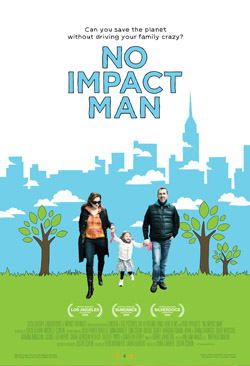
It’s a familiar pattern now: Alisa Smith and James MacKinnon ate locally for a year and wrote a book about it; Jen and Grant went zero-waste for a year, blogged and filmed a documentary about it. If doing either of those things doesn’t seem crazy and transformative enough, Colin Beavan’s family of three did both for a year, and turned off their electricity (for 6 months), self-powered their transportation, went vegetarian and stopped using toilet paper. The project, No Impact Man, is a film, a book and a blog about eliminating one’s personal impact on the environment.
The point of doing something this extreme, he cautioned, was not to suggest that everyone do it, but that everyone can do something. Individual actions, he says, inspire and engage others to act. That’s the power of community, something he says has eroded. It’s also a challenge to us to consider what really is necessary for daily life and what we could do without. As Colin puts it, living with a low impact is about “doing more good than harm.” At the end of their year, Colin’s wife Michelle decided she’d like to keep cycling (something she’d never have considered a year earlier) and not bring back their TV — except on vacation.
Continue reading Film review: No Impact Man »
I had an interesting time at Metrotown on Friday. Rows upon rows of sequined plastic iPhone cases, “50/50” t-shirts at American Apparel as if 50% polyester were a selling point, fluorescent Nikes, fake culture at Chapters induced by jazz at Starbucks, and dangerous high-heeled shoes left me feeling disconnected and a little cynical. I grew up being called weird, but looking around at this highly materialistic, throw-away, plastic culture truly made me feel weird and unable to understand its fads.
The food services produce disposable dining ware (read: garbage), poor quality food and a shockingly large crowd at McDonald’s. As my friend jokingly suggested sharing a $1.39 recipe-for-bloating, I stood there waffling between despair and a holier-than-thou attitude. I’ve become so distanced from that 12-hour a day, 7-days-a-week consumerist culture that being surrounded by it leaves me shell-shocked.
Continue reading The other 20 percent »
 David Suzuki is turning 75 on March 24. To celebrate this momentous occasion and honour his life’s work, the David Suzuki Foundation invites you to make a gift or fundraise online to support the Foundation’s work, and send a personal message to David. There are prizes involved, and those coaxed me into signing up.
David Suzuki is turning 75 on March 24. To celebrate this momentous occasion and honour his life’s work, the David Suzuki Foundation invites you to make a gift or fundraise online to support the Foundation’s work, and send a personal message to David. There are prizes involved, and those coaxed me into signing up.
But I was at a loss for what pledge to make in return for my friends’ generosity. Jenny has pledged to bike the 60+ km round trip to work and back. Siri has promised to avoid shopping sprees until the big day. It got me thinking about what change for the greener I could make, and it wasn’t easy coming up with something — not because I’m unwilling to make lifestyle changes, but because I’ve made so many that I was struggling to find something new. I know my showers could be shorter and I really ought to shut down my old iMac hog at night. I’ll come around to a permanent commitment to those eventually. I eat four or five bananas a week, my cheese comes wrapped in plastic (I eat a lot of cheese) and I’m kind of addicted to the internet. (Just kind of.) I could change one of those for a little while, no big loss for a little bit of gain. But this isn’t about guilt, it’s about inspiring people and doing something meaningful. First, though, I have to inspire myself.
So I’m going to write a blog post about the environment every day until I reach my fundraising goal of $300. Just look at my sporadic track record: I’m going to need all the moral support I can get!
I may get carpal tunnel, avoid social occasions and frequently skip flossing in order to keep this up — but it’s David’s 75th and I believe very strongly in the work he and his Foundation does.
Will you celebrate with me? Here’s how:
1) Sponsor me online. (Two donors have pledged to match the first $15,000 raised in the campaign, so you’ll essentially be doubling your donation.)
2) Write a birthday message to David.*
3) Look for your personal message to be displayed at HappyBirthdayDavidSuzuki.com within a couple business days of your submission.
I invite you to join me and write your own blog post or comment here about what you’re doing for the environment and why. Or conversely, if you’re not doing anything, why not? I won’t guilt trip you; I’m seeking to understand. Also, if you’d like to request an eco topic about which you’re yearning to know more, leave a comment and I’ll consider it for a future post.
Thank you in advance for supporting the cause that is so very dear to my heart, and valuable to the majority of Canadians.
* It’s easy to donate online at HappyBirthdayDavidSuzuki.com. To send David a message without donating, write to contact@davidsuzuki.org.

My bathroom shelf: Toothpaste, coconut oil, shea butter, oregano oil, floss and deodorant
Let’s face it: women use more products than men, and we have a recurring, generally very wasteful (but otherwise healthy) function that they don’t have. But this doesn’t mean we need to create more garbage than these low-maintenance dudes. If you live in Metro Vancouver, you’ve seen the ads, you’ve seen the news. We create a lot of garbage, and we can’t throw it on Cache Creek forever. Our rubbish has to go somewhere, so it’s time to try harder to avoid creating it in the first place. (It’s reduce, reuse, recycle, remember.) But you’re a girl, and you have needs. Now what?
Simple.
1. Get an “eco positive period“ with the Diva Cup and a combination of smart panties and reusable cloth liners and pads. The fabrics are organic cotton and the Diva Cup merely collects your flow, so you can avoid nasty things like toxic shock syndrome and yeast infections. Other benefits? No smelly waste, no crinkly noises from plastic pads, no discomfort, and no worries about running out. Yes, it can be discreet, super fun, and still feel sexy. It will simply make your life easier, save you money and time in the long run, and reduce your footprint on the planet big time. If you’re still not convinced, read their testimonials and their tips. Lunapads is based in Vancouver. Hint: sign up for their newsletter and grab the Green Zebra coupon book to save some dough.
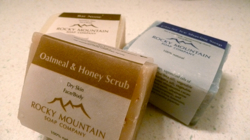 2. Happy soap! If you’re not into making your own, skip the shrinkwrap, the toxins and the plastic pumps with Rocky Mountain Soap Company‘s earth-friendly bar soap, wrapped in just a strip of paper. (Mountain Sky is another option.) They also sell a shaving* soap bar. I know you think you need foam to shave, but I dare you to try this stuff for a month and see the difference. I used to use bar soap that wasn’t even meant for shaving, then tried a foam cream in an aerosol can (what was I thinking?!). Rocky Mountain wins hands down. Their Vancouver store is on Granville & 15th, and they sell unscented soap too.
2. Happy soap! If you’re not into making your own, skip the shrinkwrap, the toxins and the plastic pumps with Rocky Mountain Soap Company‘s earth-friendly bar soap, wrapped in just a strip of paper. (Mountain Sky is another option.) They also sell a shaving* soap bar. I know you think you need foam to shave, but I dare you to try this stuff for a month and see the difference. I used to use bar soap that wasn’t even meant for shaving, then tried a foam cream in an aerosol can (what was I thinking?!). Rocky Mountain wins hands down. Their Vancouver store is on Granville & 15th, and they sell unscented soap too.
Continue reading 7 simple ways to reduce bathroom waste »
I realised when I left Pecha Kucha (at the gorgeously renovated Queen Elizabeth Theatre), in a hurry to catch my 10:20 bus, that I don’t have enough conversations with people about sustainability. I attend events where the hundreds or thousands of people in the room/theatre all have a common interest, yet I go there to absorb information, chat with friends and promptly leave. I can’t blame all of that on living in the suburbs with a typically once-per-half-hour bus. But ultimately the result is that the information I gleaned and my opinions remain for the most part locked in my head and I lose the opportunity to learn from others in my community. (And Vancouver being a small city nurses an intimate though often disconnected one.)
Dialogue takes place frequently online, but in my experience it tends to be short and superficial and, while offering participation theoretically to anyone, the reality is that many voices are left out even within our own city. That’s where dialogue in person can facilitate those deeper connections that might not otherwise be made. It also lets us communicate visually. (And with that, check out RangiChangi Roots.) An event like Pecha Kucha is available to anyone with $10 and a couple hours to spare. It won’t reach everyone, but advertising in offline and particularly free media such as the Georgia Straight (I’m not sure whether it made it to street poles) pushes its reach outside of the—to some degree—exclusive online world. Over 2000 people attended Wednesday’s event, a specially-themed “Walk the Talk, Green Your City”, which is terrifically encouraging.
Continue reading Walk the Talk, Green Your City »
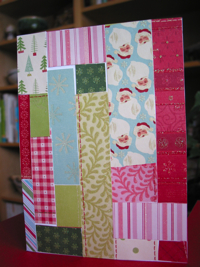 If you’re reading this you might be as last-minute with your holiday shopping as I tend to be. Admittedly my post itself is last-minute. I’ve done half my shopping and, this year, with each item I’ve put more thought than ever into what effect each will have on this finite planet. If you’re the kind of giver that prefers to give an item rather than an experience, make it meaningful not just as a useful object but as one with the smallest environmental impact possible.
If you’re reading this you might be as last-minute with your holiday shopping as I tend to be. Admittedly my post itself is last-minute. I’ve done half my shopping and, this year, with each item I’ve put more thought than ever into what effect each will have on this finite planet. If you’re the kind of giver that prefers to give an item rather than an experience, make it meaningful not just as a useful object but as one with the smallest environmental impact possible.
Before I tell you how easy it is to be eco-conscious at Christmas, you might want to know why you should:
* according to Statistics Canada, 900,000 tonnes of garbage is produced between Thanksgiving and Christmas each year
* transportion of gifts that are produced a great distance away, whether it’s Califonia or China, emits greenhouse gases that pollute our air and contribute to climate change
* logging of old-growth forests to produce “virgin” paper products releases CO2 into the atmosphere and threatens animal habitat (think of the caribou and the owls!)
* conventional plastic is a petroleum-based product, which carries a triple-threat carbon footprint
* it takes resources and produces waste to make something new and to recycle or dispose of it at the end of its life cycle (which, these days, is often pretty short!)
* that regiftable stuff is better off loved by someone else than being a guilt trip in your closet for you or your kids!
* buying local supports the local economy and friends of your friends
* and more environmental, ethical and health-related reasons…
h3. Ok, I get it. I’ll be good this year. How easy is it?
Got a bookstore nearby? A Choices/Capers/Whole Foods? MEC? Independent coffee shop? Granville Island? Main St or Commercial Drive? You can make smart choices anywhere — that includes IKEA. I did not have to go out of my way to get smart gifts for my family. A bit of thoughtfulness and planning is all it takes. And do I ever feel good about it!
Here are some suggestions and tips!
Continue reading I’m dreaming of a Green Christmas… gift, that is »




 El Naturalista (left), Simple sneaks
El Naturalista (left), Simple sneaks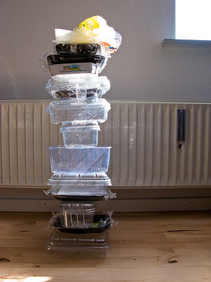 Photo by
Photo by 
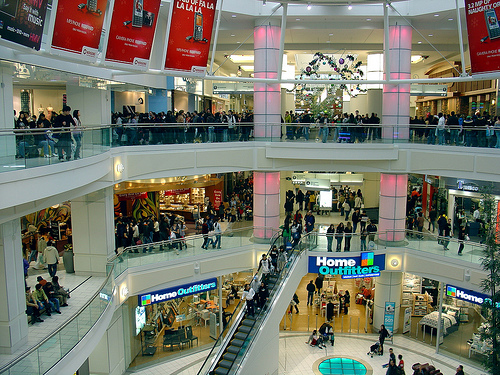 Metrotown on Boxing Day, 2006. Photo by
Metrotown on Boxing Day, 2006. Photo by 

 2. Happy soap! If you’re not into making your own, skip the shrinkwrap, the
2. Happy soap! If you’re not into making your own, skip the shrinkwrap, the  If you’re reading this you might be as last-minute with your holiday shopping as I tend to be. Admittedly my post itself is last-minute. I’ve done half my shopping and, this year, with each item I’ve put more thought than ever into what effect each will have on this finite planet. If you’re the kind of giver that prefers to give an item rather than an experience, make it meaningful not just as a useful object but as one with the smallest environmental impact possible.
If you’re reading this you might be as last-minute with your holiday shopping as I tend to be. Admittedly my post itself is last-minute. I’ve done half my shopping and, this year, with each item I’ve put more thought than ever into what effect each will have on this finite planet. If you’re the kind of giver that prefers to give an item rather than an experience, make it meaningful not just as a useful object but as one with the smallest environmental impact possible.